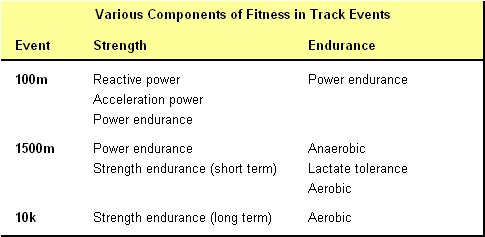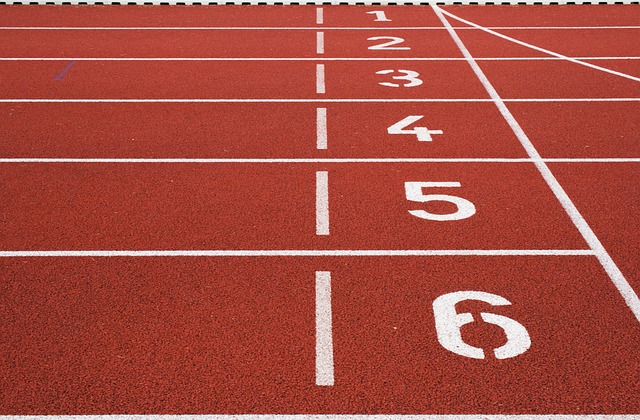This section of the site is dedicated to athletics training for the track events.
As any track athlete will know, conditioning for one event will be significantly different compared to another. While the ATP-PCr energy system predominates in the 100 and 200 metre sprints, the oxidative system is relied on in events lasting over 2 minutes.
Athletic training is a measured combination of strength, power, endurance, speed and flexibility conditioning. Of course not all forms of conditioning are applicable to all events and selecting both the right types of training and the most specific exercises is an important, energy-conserving principle.

The more sport-specific a training plan is, the more successful it will be. The articles below focus on the specific demands of each track event, with athletics training suggestions for each. Events covered include:
- 100 metres
- 200 metres
- 400 metres
- 800 metres
- 1500 metres (mile)
- Steeplechase
- 3000 meters (3k)
- 5000 meters (5k)
- 10,000 metres (10k)
- Marathon
- 110 metre hurdles
- 400 meter hurdles
- 20k walk
- 50k walk
Athletics Training (Track) Articles
The Different Types of Endurance Training
Endurance is the major component of distance runner’s athletics training program. Interval training, fartlek training, tempo runs… there are several distinct forms of endurance training – here they are with some sample plans…
VO2max – Your Aerobic Potential
VO2max and endurance performance seem to go hand in hand. While it does play a major role in your endurance potential it is not the be all and end all…
Lactate Threshold – Tapping Your Aerobic Potential
Lactate threshold is more trainable than VO2max… and a more accurate predictor of performance in endurance events…
Determining Your Anaerobic Threshold
Which tests are the most accurate and reliable for measuring your anaerobic threshold? There are several non-invasive methods that can be used outside of a laboratory setting…
Training to Improve Lactate Threshold
Delaying the onset of blood lacate accumulation is a key strategy in endurance performance. Here are training guidelines for doing just that…
Interval Training
Distance runners have traditionally favored only long, slow distance training. However, there is evidence to suggest substituting some of their low-intensity mileage for higher intensity interval training can improve performance and reduce the risk of injury…
Heart Rate Training for Athletes
Despite its limitations, heart rate remains a popular and practical training aid…
Lactic Acid, Blood Lactate & The ‘Lactic Acid Myth’
Blood lactate is not a waste by-product of exercise. This fully referenced article looks in detail at what current research suggests is more of a friend than foe…
Advanced 10k Training Program
If you’re an experienced runner, this 8-week, 10k training program is designed to improve your times by incorporating more advanced forms of conditioning…
The Sport-Specific Approach to Strength Training Programs
Every track athlete from distance runners to sprinters, can benefit from strength training. However, it must reflect the demands of the event – power, strength endurance or a combination of the two. This article examines the core concept of developing a sport-specific strength program…
How To Design Resistance Training Programs For Athletes
This step-by-step guide covers the various design elements of a successful, sport-specific strength training regimen…
Power Training for Athletes
Many track athletes (particularly sprinters) require explosive power to be successful in their event. Once maximal strength has been developed there are several methods to convert it into sport-specific power…
Plyometric Training for Athletic Power
Plyometrics is a buzzword in athletics training. It’s a simple concept and one that is proven effective for increasing an athlete’s power. But you must get the fundamentals right…
Core Strength Conditioning For Athletes
Develop your centre of power with these core strengthening exercises…
Using Power Cleans in Athletics Training
Power cleans can be useful for developing explosive power (in appropriate events). Use this technique guide and animated images to see how the lift should be performed…
Designing a Speed Training Program
Athletics training principles and program suggestions for speed development…
How to Improve Your Sprinting Technique
Proper form is essential for sprint athletes. Here’s a breakdown of the movement and tips for improving your own technique…
Flexibility Exercises and Stretching Program
Good flexibility is prerequisite to successful performance in any athletic event. Here are some of the more common static stretching exercises…
Self Myofascial Release Exercises
Many athletic coaches and therapists are now using myofascial release to prevent injury and aid healing…
Delayed Onset Muscle Soreness (DOMS)
Can DOMS be prevented or treated? Here’s what current research suggests…
Altitude Training
Altitude acclimatization is essential for competing at high levels. But can it improve performance at sea-level?

Jacky has a degree in Sports Science and is a Certified Sports and Conditioning Coach. He has also worked with clients around the world as a personal trainer.
He has been fortunate enough to work with a wide range of people from very different ends of the fitness spectrum. Through promoting positive health changes with diet and exercise, he has helped patients recover from aging-related and other otherwise debilitating diseases.
He spends most of his time these days writing fitness-related content of some form or another. He still likes to work with people on a one-to-one basis – he just doesn’t get up at 5am to see clients anymore.
